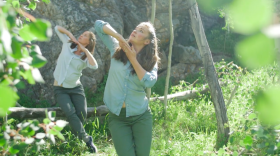An outdoor dance project out of Carbondale called “Letter to Congress: A WILD Sanity” advocates for the protection of public lands through movement. Now the group of artists intend on getting the film in the hands of our elected officials in Washington.
The film project combines dance, music and spoken word poetry to connect viewers with the psychological benefits of having access to, and being good stewards of, public lands in the American west.
Deborah Colley is the project’s artistic director and dance choreographer. She said her call to action came when President Trump signed an executive order this year requesting the U.S. Department of the Interior to review two dozen national monument designations.
“That deeply disturbed me,” she said. “Just simply because there’s not, really and truly, a lot of wild land or public lands left that haven’t been modified …”
The Trump administration is considering modifications to a number of national monuments. Last week, more details were made public. Secretary of the Interior Ryan Zinke made the recommendation that at least four land monuments be shrunk. This includes Utah’s Bears Ears and Grand Staircase-Escalante, Nevada’s Gold Butte and Oregon’s Cascade-Siskiyou.
As a former environmental educator, Colley believes this decision could pull the rug out from underneath equality for all Americans.
“Even though not everyone in the United States lives next to public lands, everybody has access to them,” said Colley. “Everyone can go to them. They belong to all of us.”
Colley said she wants to reach lawmakers through the film “Letter to Congress: A Wild Sanity,” because art has the capability to evoke emotion, to pull at their heartstrings.
“I feel like the full picture of a written and spoken narrative – with music and dancers and a beautiful natural setting on public land – like, all of that might be able to hit some different feelings in our legislators that maybe they're not getting if they just read something on paper,” said Colley.
The filmmaker for this project is Jeremiah Hutchens, who has a history of working in film in Carbondale.
“I came from a background of wanting to make short films and feature films, and so it’s more of a, I guess a cinematic way of capturing things that I was trained to do,” said Hutchens. He shot the film in locations throughout the White River National Forest, documenting a small collective of dancers. Meagan Shapiro is one of those dancers.
“There were times where it was easier to get to this location so we’re doing all of this location first, but that location is spread out throughout the film,” said Shapiro. “So we had to, in our brains and our bodies, sort of compartmentalize pieces of the work.”
Then there was the added element of performing in the wild, where the terrain is uneven and often unpredictable.
“Most dancers, if not all dancers, love a big open empty room,” Shapiro started. “But it has four walls. And so when you take your work outside and you take it into a different venue, you just get expanded.”
Last month, the group performed the choreography in front of an audience at Sustainable Settings Ranch in Carbondale. For these live shows, the dancers had to learn the choreography in the linear form ... and audiences walked to different locations stages set up around the property.
“I'm just curious if something like the performing arts really pulls on other sorts of our own humanity,” said Colley. “Like, I'm curious if that will speak more strongly than just the analytical.”
Colley and filmographer Hutchens are editing the work, which they’re hoping to showcase at film festivals across the country. Colley will debut the trailer at the 6th annual Spectrum Dance Festival at The Launchpad in Carbondale on Friday. The next step will be getting it screened in our nation’s capitol.




